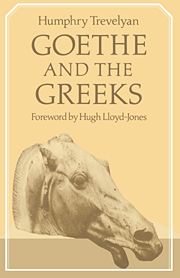Book contents
- Frontmatter
- Contents
- PREFACE
- BIBLIOGRAPHY
- ABBREVIATIONS
- CHAPTER I CHILDHOOD & YOUTH
- CHAPTER II FROM HERDER TO WEIMAR (SEPT. 1770–NOV. 1775)
- CHAPTER III WEIMAR
- CHAPTER IV ITALY
- CHAPTER V FULL CLASSICISM: 1788–1805
- CHAPTER VI LAST YEARS: 1805–1832
- CONCLUSION
- APPENDICES
- A DATE CHART
- B GOETHE'S THEORY AND PRACTICE IN WRITING GERMAN HEXAMETERS
- INDEX
B - GOETHE'S THEORY AND PRACTICE IN WRITING GERMAN HEXAMETERS
Published online by Cambridge University Press: 15 December 2009
- Frontmatter
- Contents
- PREFACE
- BIBLIOGRAPHY
- ABBREVIATIONS
- CHAPTER I CHILDHOOD & YOUTH
- CHAPTER II FROM HERDER TO WEIMAR (SEPT. 1770–NOV. 1775)
- CHAPTER III WEIMAR
- CHAPTER IV ITALY
- CHAPTER V FULL CLASSICISM: 1788–1805
- CHAPTER VI LAST YEARS: 1805–1832
- CONCLUSION
- APPENDICES
- A DATE CHART
- B GOETHE'S THEORY AND PRACTICE IN WRITING GERMAN HEXAMETERS
- INDEX
Summary
(This Appendix is not an exhaustive study of Goethe's practice in adapting ancient metres to the German language. The problems with which he had to deal in writing German hexameters were the same as those which the trimeter and the choric metres presented to him. The general principles with which he attempted to solve the one set of problems may be assumed to be the same as those with which he approached the other.)
Andreas heusler, in his invaluable essay, Deutscher und Antiker Vers (Strassburg, 1917), maintains that the experts on metre in Goethe's day, Moritz, Voss, and A. W. Schlegel, did not appreciate the difference between quantity and accent, and spoke of a “long” syllable when they meant an accented one. This is certainly not true of Moritz, whose Versuch einer deutschen Prosodie Goethe had studied in Rome, nor of Voss, to whom from 1793 onwards Goethe turned for guidance in writing German hexameters and elegiacs. In Ueber den deutschen Hexameter (reprinted 1831 from the preface to his edition of the Georgics of 1789), Voss makes it quite clear that a sense of time values was the basis of the ancient hexameter (p. 183); and in his Zeitmessung der deutschen Sprache (published together with Ueber den deutschen Hexameter) he ridicules (p. 8) those who think that “hoher Ton” (accent) is the same as “Länge” (quantitive length).
- Type
- Chapter
- Information
- Goethe and the Greeks , pp. 295 - 300Publisher: Cambridge University PressPrint publication year: 1981



